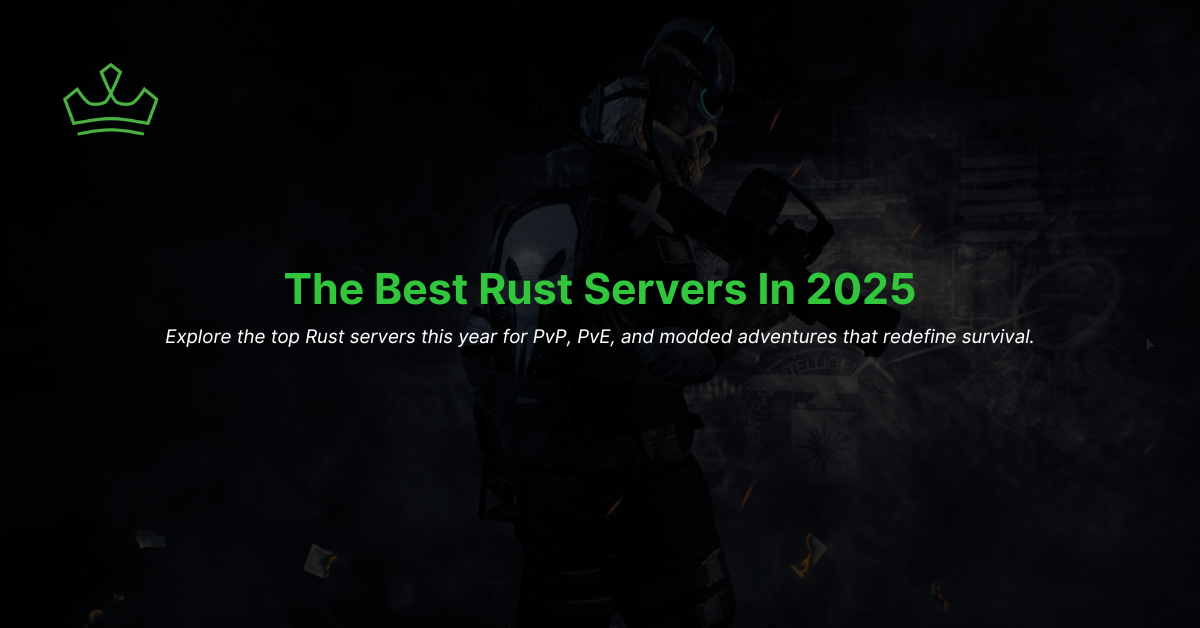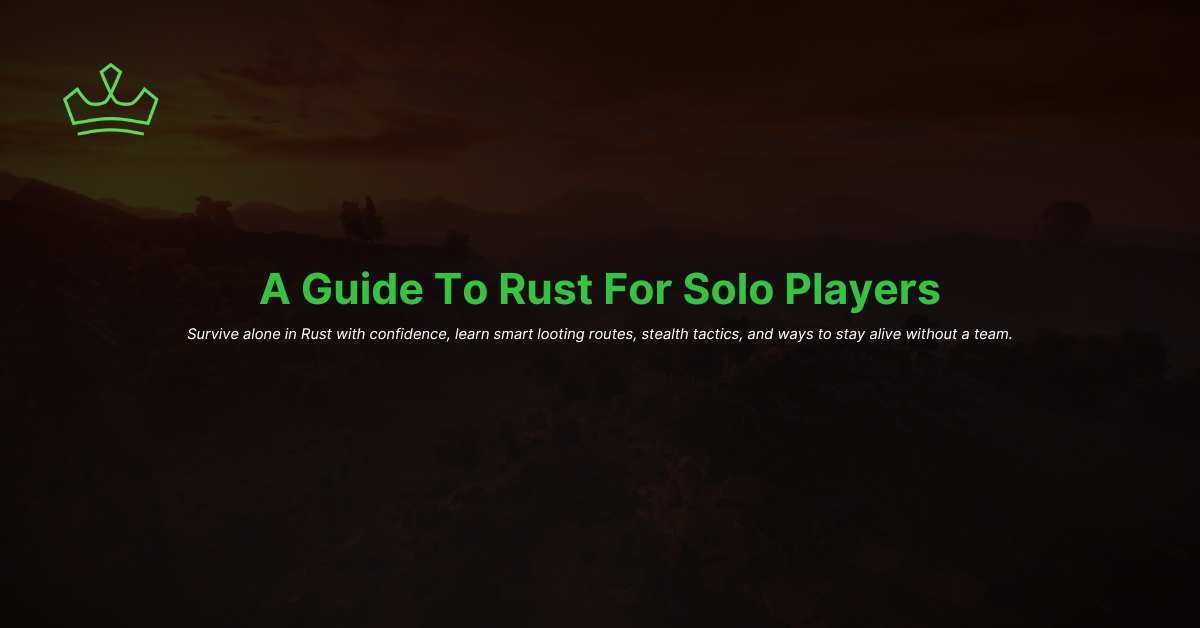Building a base in Rust is the foundation of your survival. Whether you’re playing your first wipe or returning after a break, learning to build efficiently determines how long you stay alive, how well you protect your loot, and how quickly you progress.
A strong base gives you a safe respawn point, storage for valuable resources, and protection against raiders and wildlife. If you understand the basics early, your entire wipe becomes smoother and far less frustrating.
This guide walks you through everything you need as a beginner, how to choose a location, how materials work, how to place your Tool Cupboard correctly, and how to build your first 2×1 starter base. You’ll also learn the proper upgrade path, beginner mistakes to avoid, and why starting small is key.
If you want an easier time spotting resources or defending your base, you can also check out our Rust cheats for ESP, aimbot, and fully stream-proof features.

A Quick Overview For Beginners
Before you place your first foundation, it’s important to understand what a starter base is and why it’s essential. A starter base is a small, fast-to-build structure that gives you immediate protection and a place to store loot safely.
Many new players make the mistake of trying to build a large base immediately, which drains resources and leads to decay or being raided before you’re ready.
Below is a simple, scannable table outlining what beginners need before building:
| Category | Beginner Tips | Why It Matters |
| Resources Needed | Wood, Stone, Metal Fragments | You cannot upgrade or maintain your base without these materials. Stone is especially important for early protection. |
| First Tools | Building Plan, Hammer, Stone Hatchet, Stone Pickaxe | These tools allow you to gather resources and construct and upgrade your base. |
| Minimum Starter Base | A simple 2×1 layout with an airlock | Small, cheap, and quick to secure so you can protect your loot. |
| Ideal Player Count | Solo or Duo | Small groups benefit from smaller upkeep and easier building. |
Small bases work best early on because they are cheap to upgrade, easier to defend, and give you a safe point to expand from. Once you are established, you can expand your design into something more durable and complex.

How To Choose The Perfect Base Location
Your base location determines whether you’ll thrive or spend your wipe respawning on the beach. Map location affects raid risk, resource access, player traffic, and your ability to defend yourself. New players should avoid crowded monuments and instead focus on areas with good visibility and consistent node spawns.
Here’s a breakdown of each biome to help you pick the right spot:
| Biome | Pros | Cons |
| Snow | High node density for stone, metal, and sulfur | Requires heat management, harsh for new players |
| Desert | Good visibility, plentiful crates and barrels | High player activity, risky for beginners |
| Temperate | Balanced resources, easy survival conditions | Medium player traffic depending on monuments |
Other things to consider when choosing a location:
- Player Traffic: Avoid placing your base next to Airfield, Launch Site, or roads with heavy activity.
- Monument Proximity: Being close to a small monument is useful, but avoid high-tier ones early.
- Elevation: Higher ground gives visibility, while lower ground may hide your base better.
- Terrain: Build on stable, mostly flat terrain to prevent structural issues.
Beginners should choose moderate-traffic zones with easy access to stone nodes and wildlife. A well-chosen location often matters more than the base design itself.

Tools, Materials, And Your First Tool Cupboard
Understanding Rust’s building tools and materials is crucial before constructing your base. You only need two tools to start building: the Building Plan to place structures, and the Hammer to upgrade them. But the most important object in your base is the Tool Cupboard (TC).
The TC controls your building privilege, protects your structure from decay, and prevents other players from building near or inside your base. Because of its importance, TC placement must always be secure and difficult for raiders to reach.
Rust has several building tiers. Here’s how they compare:
| Tier | Material Cost | Strength | Notes |
| Twig | Extremely low | Extremely weak | Use only for planning; upgrade immediately |
| Wood | Low | Basic protection | Weak to fire and flamethrowers |
| Stone | Moderate | Strong early-game durability | Ideal for beginners; protects against most early tools |
| Sheet Metal | High | Strong against explosions | Common mid-game upgrade |
| Armoured | Very expensive | Extremely strong | Late-game defense only |
Upkeep is another mechanic beginners often overlook. Your TC must contain enough material to prevent decay. Even stone bases need daily upkeep when small. As your base grows, upkeep becomes one of your largest expenses.
To progress faster, especially for gathering stone, metal, and scrap, Rust ESP from our product page can help you locate nodes, animals, and loot efficiently.

How To Build Your First Starter Base In Rust
A simple 2×1 base is the best starting design for new players. It’s easy to build, cost-efficient, and strong enough for early wipe defense. Below is a step-by-step guide to constructing a solid starter base.
Step 1: Lay foundations and walls
Place two square foundations side-by-side. Add walls around the perimeter, leaving one frame free for your main door. This forms the core structure of your base.
Step 2: Add an airlock
An airlock prevents players from entering your base if you accidentally open the wrong door. Add a triangle foundation outside your entrance, then place two walls and a second door. This simple addition is one of the best defenses in Rust.
Step 3: Place the TC securely
Your TC should be placed deep inside your base, behind multiple doors or walls. Many players place it behind a half wall with a roof tile over it for extra protection.
Step 4: Add storage, furnace, and a sleeping bag
Organize your space carefully. A 2×1 can fit a furnace, multiple small boxes, a sleeping bag, and your TC without feeling cramped if arranged properly.
Step 5: Seal the base and upgrade weak points
Upgrade your foundations and core walls to stone immediately. Wood bases attract raiders because they are extremely cheap to destroy.

Defensive Base Upgrades: Airlocks And Honeycombing
Once your starter base is secured, the next step is reinforcing it. Defense in Rust is about increasing the cost, time, and effort required for raiders to reach your loot.
Here are the most effective early-game defensive upgrades:
| Upgrade Type | What It Does | Best Time To Add It |
| Airlock | Prevents raiders from entering if you open the wrong door | Immediately |
| Double Doors | Doubles durability and allows door stacking | Early game |
| Honeycombing | Adds extra layers of walls to increase raid cost | Mid-game after stone upgrades |
Airlocks are essential from the very beginning. Honeycombing becomes useful once you have an established resource supply and are ready to expand beyond your starter base.

Avoid Common Beginner Mistakes
Rust has a steep learning curve, and many new players make the same preventable mistakes. Avoiding them gives you a huge advantage early in the wipe.
Here are the most common errors and how to fix them:
- Leaving the TC unlocked: Always add a keylock or code lock immediately.
- Building too big too early: You will not have the resources to sustain upkeep.
- Leaving twig inside the base: Raiders can break twig with a single hit.
- Using a single-door entrance: Easy to camp and easy to breach.
- Poor door direction: Ensure your doors swing outward for better defense.
- Bad furnace placement: Keep furnaces away from doors to prevent theft.
- Ignoring the roof: Players can jump in through unprotected roof tiles.
Fixing these mistakes early drastically improves your base’s survival during the wipe.

The Ideal Upgrade Path For New Players
Upgrading your base in the correct order is essential. Many beginners waste materials by upgrading walls that don’t matter or expanding before securing critical weak points.
Follow this simple, optimized upgrade path:
- Upgrade all doors to sheet metal: Doors are always targeted first.
- Strengthen your airlock: Losing it gives raiders immediate access.
- Upgrade foundations and external walls to stone: Prevents cheap raiding tools from breaking in.
- Secure the roof: Jump-ins are a common way to bypass defenses.
- Add honeycombing once the core is solid: Makes raids significantly more expensive.
- Expand only once upkeep is sustainable: Growth should match your resource income.
This progression ensures that your base stays strong at every stage without wasting materials.

Key Takeaways For Your First Rust Base
When building your first Rust base, the most important thing is to keep your design simple and manageable. Starting small helps you avoid expensive upkeep and reduces the chance of becoming an early raid target. Focus on upgrading in the correct order, with doors, airlocks, and other entry points taking priority over cosmetic improvements.
Protecting your Tool Cupboard should always come first. If you lose the TC, you lose the entire base, so treat it as the heart of your build. Make sure all entrances, roofs, and foundations are secure before you think about expanding. Strong fundamentals make a much bigger difference than size in the early game.
As you play, experiment with different layouts and refine your approach. Each wipe teaches you something new and every improvement helps you become a more confident and efficient Rust builder. The goal is progress, not perfection, and even small changes can have a huge impact on your survival.
To help you progress faster, and find all the materials for your base, explore our Rust ESP!

Rust Base Building FAQs
Below are the most common questions new players ask when learning how to build a base in Rust:
How do I build a proper base in Rust?
Start with a small 2×1 or 2×2 base, add an airlock, place your TC deep inside, and upgrade your foundations and walls to stone as soon as possible.
How do I stop my base from decaying?
Add enough materials to your TC to cover upkeep. Stone walls need stone, sheet metal needs metal fragments, and so on.
How do I build a foundation in Rust?
Equip a Building Plan, select the foundation option, and place it on stable ground. Make sure there are no terrain restrictions before upgrading.
How many doors should a beginner base have?
At least two doors with a proper airlock. More can be added once your base expands.
When should I upgrade my base to stone?
Immediately. Never leave wood walls up longer than necessary, especially during active hours on the server.
What size base should a solo player build?
A 2×1 or 2×2 is ideal for solos. It’s small, cost-efficient, and easy to upgrade.




